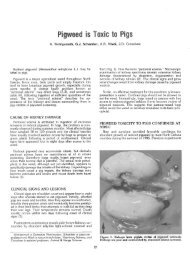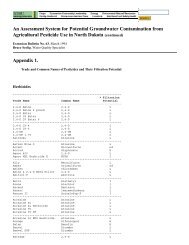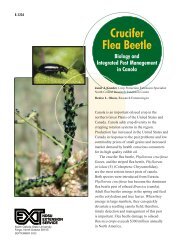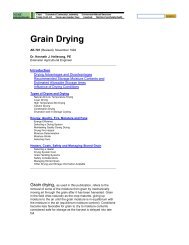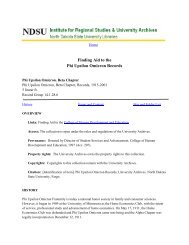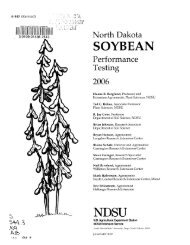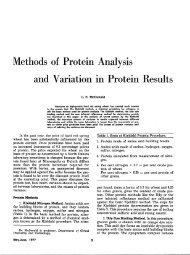Yield Mapping and Use of Yield Map Data
Yield Mapping and Use of Yield Map Data
Yield Mapping and Use of Yield Map Data
- No tags were found...
You also want an ePaper? Increase the reach of your titles
YUMPU automatically turns print PDFs into web optimized ePapers that Google loves.
<strong>Yield</strong> <strong><strong>Map</strong>ping</strong> <strong>and</strong> <strong>Use</strong> <strong>of</strong> <strong>Yield</strong> <strong>Map</strong> <strong>Data</strong>Site-specificFarming3grain stream, are unreasonably low or high yields. Forexample, in a fi eld <strong>of</strong> spring wheat that varies from 20 to50 bushels per acre (bu/acre), some yield points may beas high as 150 bu/a. These actual yields most likely donot exist, so choosing a more reasonable maximum yieldis desirable.In fi elds with soluble salt problems, zero yield ispossible. Cleaning the lower end <strong>of</strong> the yield sort is morediffi cult. In this case, the area <strong>of</strong> actual zero yield wouldneed to be identifi ed within the data set <strong>and</strong> only thosedata not within the problem area should be consideredfor cleaning.In fi elds where actual grain yields are not zero,choosing some lower limit <strong>of</strong> yield also would berecommended. A data sort from high to low within aspreadsheet then can be conducted, <strong>and</strong> yields above<strong>and</strong> below the limits can be deleted from the dataset. Some precision-ag consultants have their ownproprietary cleaning s<strong>of</strong>tware. A public arena download<strong>of</strong> yield data-cleaning s<strong>of</strong>tware is available from theUSDA-ARS in Missouri (Suddoth, 2007) at www.ars.usda.gov/services/s<strong>of</strong>tware/download.htm?s<strong>of</strong>twareid=20.Since small spatial errors occur among yieldmeasurements, yield monitor data usually are displayedas maps in larger zones <strong>of</strong> varying yield ranges. Theseyield maps are useful to producers because they visuallyshow that yields vary throughout the fi eld <strong>and</strong> where theyields are high, low <strong>and</strong> in between without the clutter<strong>of</strong> individual dots that vary widely in value. For visualdisplay, choosing yield increments that make sense ishelpful. For example, in a corn fi eld, choosing displayranges <strong>of</strong> 30 bu/acre in a fi eld that averages 200 bu/acreis probably appropriate. Displaying ranges <strong>of</strong> 10 bu/acre increments would create a map that would be too“busy” <strong>and</strong> hard to interpret. In contrast, a spring wheatfi eld that averaged 40 bu/acre would need increments<strong>of</strong> about 10 bu/acre or less to be meaningful. Thirty bu/acre increments may not show important variation fromthe average.Although the yield map itself is a useful tool thatillustrates the management <strong>and</strong> climate results forthe current growing season, yield maps also may bepredictive <strong>of</strong> future yield potential <strong>and</strong> might be relatedto the availability <strong>of</strong> certain soil nutrients, such asnitrogen. Single-year yield maps for predictive purposeshave not been nearly as useful as multiyear yield maps.A multiyear yield map also is called a “yield frequencymap.”Whether a fi eld has had a history <strong>of</strong> a single cropor a diverse crop rotation, the same general procedureshould be followed to create a yield frequency map. Afi eld that has been in wheat continuously for 10 yearsmight average 80 bu/acre one year <strong>and</strong> 20 bu/acreanother year. The actual bushels for the fi eld thereforecannot be used when the data sets are combined. Ifthe fi eld was corn one year, soybeans the next, wheatthe next <strong>and</strong> then sunfl owers the year after, these yieldsobviously cannot be added to each other spatially withany meaning. The range <strong>of</strong> yields in any year thereforemust be “normalized.”Normalization is a simple mathematical exercise thatconverts bu/acre into relative yield. In the example year <strong>of</strong>high wheat yield with highest cleaned yield <strong>of</strong> 80 bu/acre,divide each yield by 80. The range <strong>of</strong> yields is thereforefrom 0 to 1. If the next year is canola <strong>and</strong> the highestcanola yield is 3,500 pounds/acre, divide each yield by3,500. The range <strong>of</strong> yields is from 0 to 1.Another way to normalize yield data is to normalizeit at the end <strong>of</strong> analysis <strong>and</strong> not at the beginning. Usingthe following fi gures as examples, fi rst impose a grid onthe yield data that makes some sense. A fi eld shouldhave at least 40 grids to produce a meaningful map at theend <strong>of</strong> the exercise. For example, a user might chooseto superimpose 40 1-acre grids over a 40-acre fi eld. Aquarter-section might have 2-acre grids. A 20-acre fi eldmight have ½-acre grids.To create the grids <strong>and</strong> the average yield within agrid, use a s<strong>of</strong>tware program such as Surfer (GoldenS<strong>of</strong>tware Co., Golden, Colo.) or ArcGIS (ESRI GISS<strong>of</strong>tware Co., Redl<strong>and</strong>s, Calif.) that can import spatialdata <strong>and</strong> then convert them to estimated values. Thisestimation feature usually is used for taking less densedata <strong>and</strong> estimating values at small distances. However, italso can be used to take densely sampled data, such asthe thous<strong>and</strong>s <strong>of</strong> points <strong>of</strong> yield data, <strong>and</strong> average themwithin a less dense grid <strong>of</strong> your choosing. In Surfer, theresulting grid fi le can be saved in an ASCI text fi le <strong>and</strong>then uploaded into a spreadsheet.Within the spreadsheet, the grid is given a +1, -1 or0 value, depending on whether the average <strong>of</strong> the grid isgreater than the fi eld average, less than the fi eld averageor within ½ bu/acre <strong>of</strong> the fi eld average. Giving the +1, -1or 0 is a normalization procedure. Then these normalizedgrids can be exported into a spreadsheet <strong>and</strong> summedby grid with other years <strong>of</strong> data that have been treated



